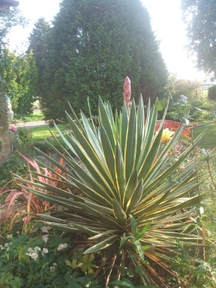A question about snail eggs in flowers
In my garden there is a 10-year-old winter hardy plant, something like a yucca without a stalk, and it's not an agave (see picture). It has broad, sword-shaped leaves which curve inwards at the tip to a ferocious point. This year (2008) the plant produced a tall, round, 10cm diameter flower spike. Looking inside, it was obvious something was chewing away at the compressed flowers. The culprits were not hard to find! Where the leaves curve in at the tips there was a cosy little depression containing a mass of eggs, newly emerged snails and juveniles at various stages to half-grown, mostly Helix aspersa. There were also a few Cepaea hortensis nearby, lower down on the leaves, sitting by themselves. I think these were adults,and nothing to do with the eggs. The eggs must somehow have been laid in the flower spike earlier in the season in order to hatch at the correct time (September). Does anyone know any more about this?
I have been told that snails lay their eggs low down at the base of plants or in the soil, and then they climb up. When I objected that some were too small to climb up, being only pinhead size, the reply was that "No matter how small, they will climb up and all over the place."
Does anyone know any more about this? If so, please email me at the address below.
Barbara Spalding
This item was first posted in 2008.


